
13 August 1973 - Kassák Theatre performances
augusztus 13. - King Kong I–II. parts
augusztus 14. - King Kong III. part
augusztus 16–17–18. - King Kong I–II–III. parts
Participants: István Bálint, Péter Breznyik, Éva Buchmüller, Péter Halász, Marianne Kollár, Anna Koós, Miklós Kovács, István Szeghő, Can Togay
KING KONG
a three-day piece — the chapel at Balatonboglár, summer 1973*
The word has been out since the spring: György Galántai, who has been renting an abandoned chapel in a village at Lake Balaton, organizes an open festival — on his own initiative. He invites many of his artist friends to create happenings, performances and exhibits for the summer. Visitors will travel by train or hitchhike from the capital; they may stay in the village, or sleep in the park.
DAY 1: PROCESSION AND SACRIFICE AT SUNSET
The church stands on top of a hill, at the end of a calvary. As a Japanese gong from the bell tower commences the show, a blue ball rolls along a tree-flanked alley. A man in a suit sprinkles sugar in the wake of the ball. Elegantly dressed men and women walk slowly along. A dwarf trails them pulling a red tape along the trees. An audience emerges from the surrounding park and follows the procession to the chapel.
Upon entering the church everyone settles around a large table in the middle. A giant ape presides over the scene. Spectators are served hot chocolate and challah bread — a communion. Meanwhile, an actor reads a Japanese tale about the King of Apes who threatens to destroy the village unless a woman is sacrificed to him.
At the head of the table, Petya prepares for his transformation into a woman. He makes an actual incision in his arm and lets a few drops of his blood fall into a glass of milk, which he will later drink as sacrificial wine.
He undresses, and once naked, hides his genitals behind crossed legs. Marianne helps him into a dress and puts the final touches on his makeup.
Petya is now the Beautiful Lady of New York.
DAY 2: FIGHT IN THE EVENING
In front of the chapel wearing a huge backpack, the dwarf is on display behind a fence. As people gather around him, he becomes excited and pokes at them with his walking stick, making angry faces.
In the chapel, war is declared on King Kong: men in white shirts stretch their arrowless bows; others hide under the table. The dwarf makes his way into the chapel and curses the beast.
The Beautiful Lady of New York tries to seduce King Kong by climbing the steps to the choir loft and talking to his head. Petya later descends to caress King Kong’s phallus, a naked man in a red swimming cap. The Phallus slowly slides forward and bellows: “Let the Priests of the Raven of dawn, no longer in deadly black, with hoarse note curse the sons of joy. Nor his accepted brethren whom, tyrant, he calls free; lay the bound or build the roof. Nor pale religious letchery call that virginity, that wishes but acts not! For everything that lives is Holy.” But earthly forces prevail and tear the phallus out of the giant ape.
DAY 3: FEAST IN THE AFTERNOON
The dwarf embroiders a piece of cloth with thread similar to King Kong’s hair. He is behind his fence outside the chapel. The Beautiful Lady of New York arrives and snatches the rag from the dwarf’s lap. The dwarf levitates. Pop music rocks inside the chapel. King Kong’s tom phallus lies on the ground with red tape strapped across his body. Spectators and performers dance together.
*Description published in: Buchmuller, Eva – Anna Koós: Squat Theatre, Artists Space, New York, 1996, pp. 18–20.
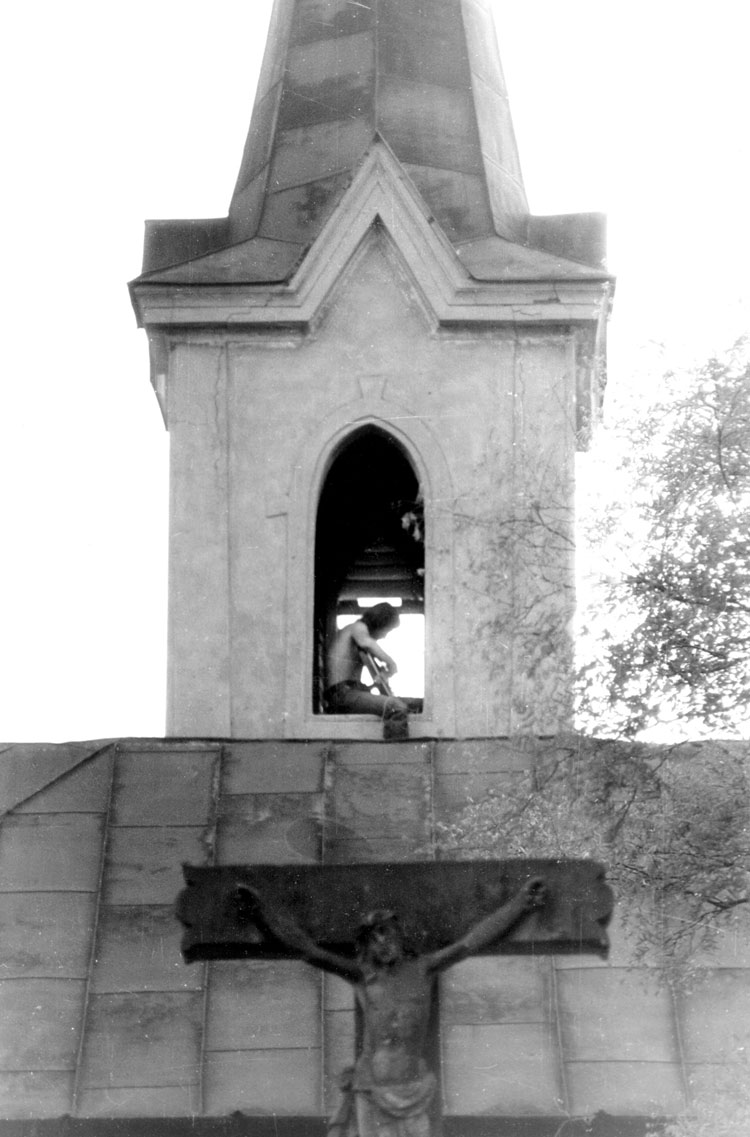
In the tower: György Kurtág Jr.
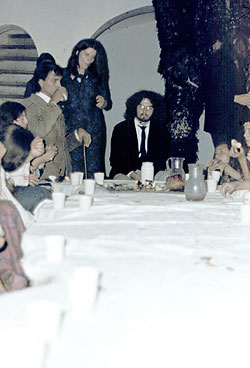
Audience and performers around the table
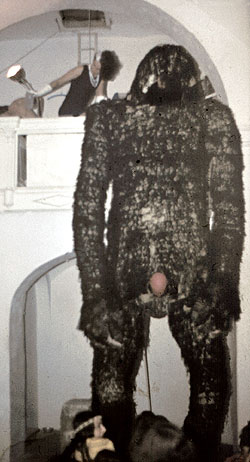
The “woman” (Péter Breznyik) flirts with the monkey
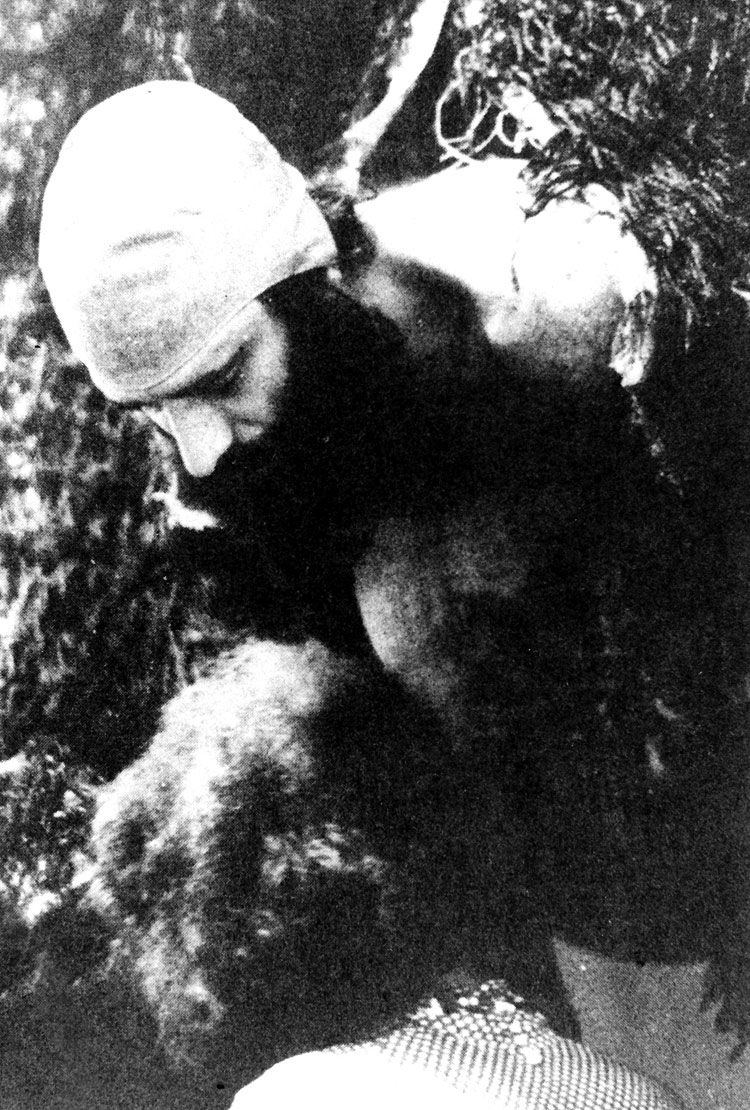
The “phallos” (Péter Halász) recites a quote by Blake
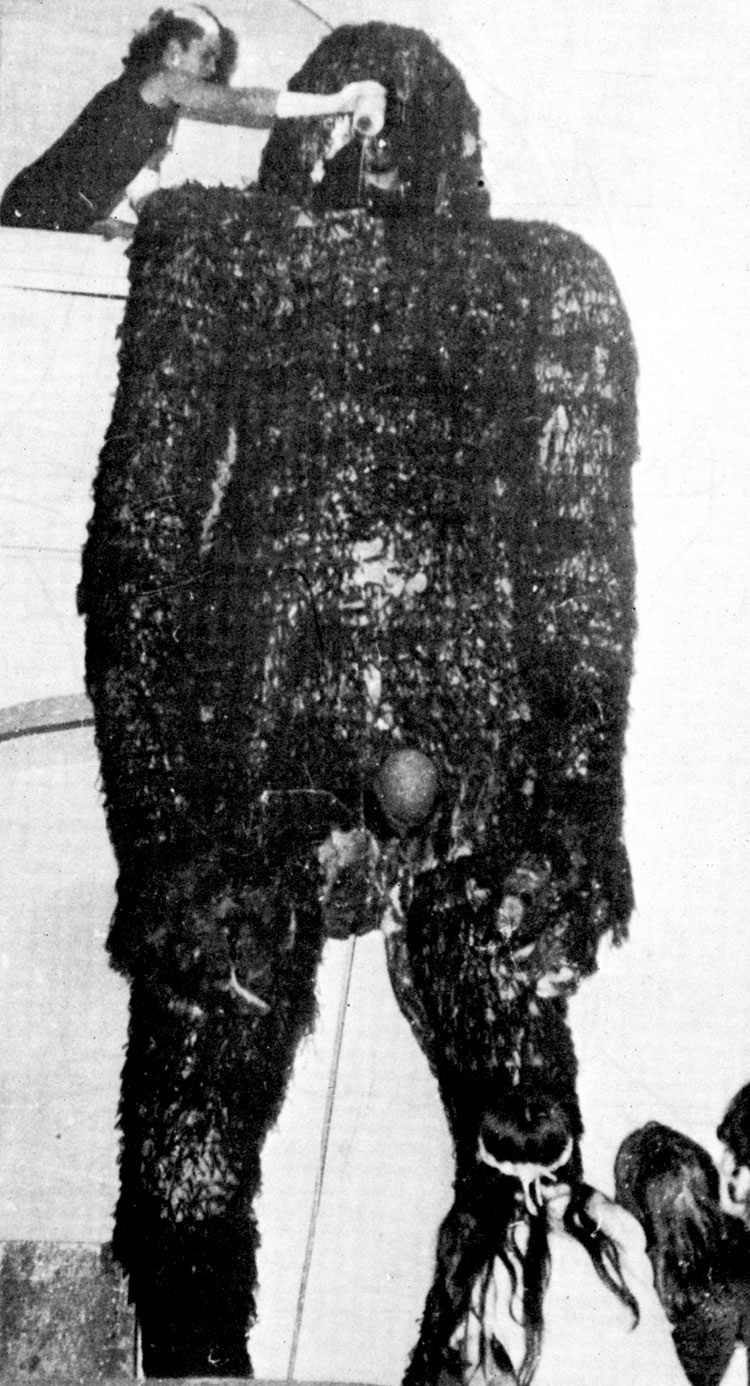
The “woman” (Péter Breznyik) flirts with the monkey
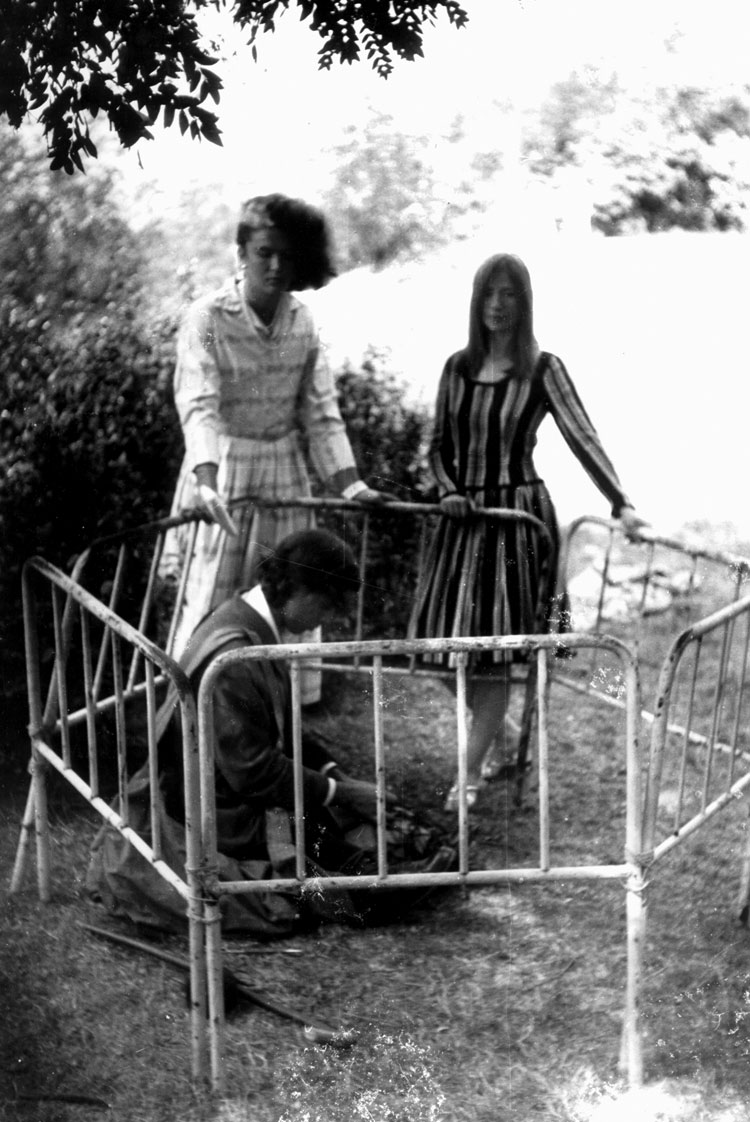
In the cage Can Togay (the “dwarf”), behind
him Péter Breznyik and Marianne Kollár
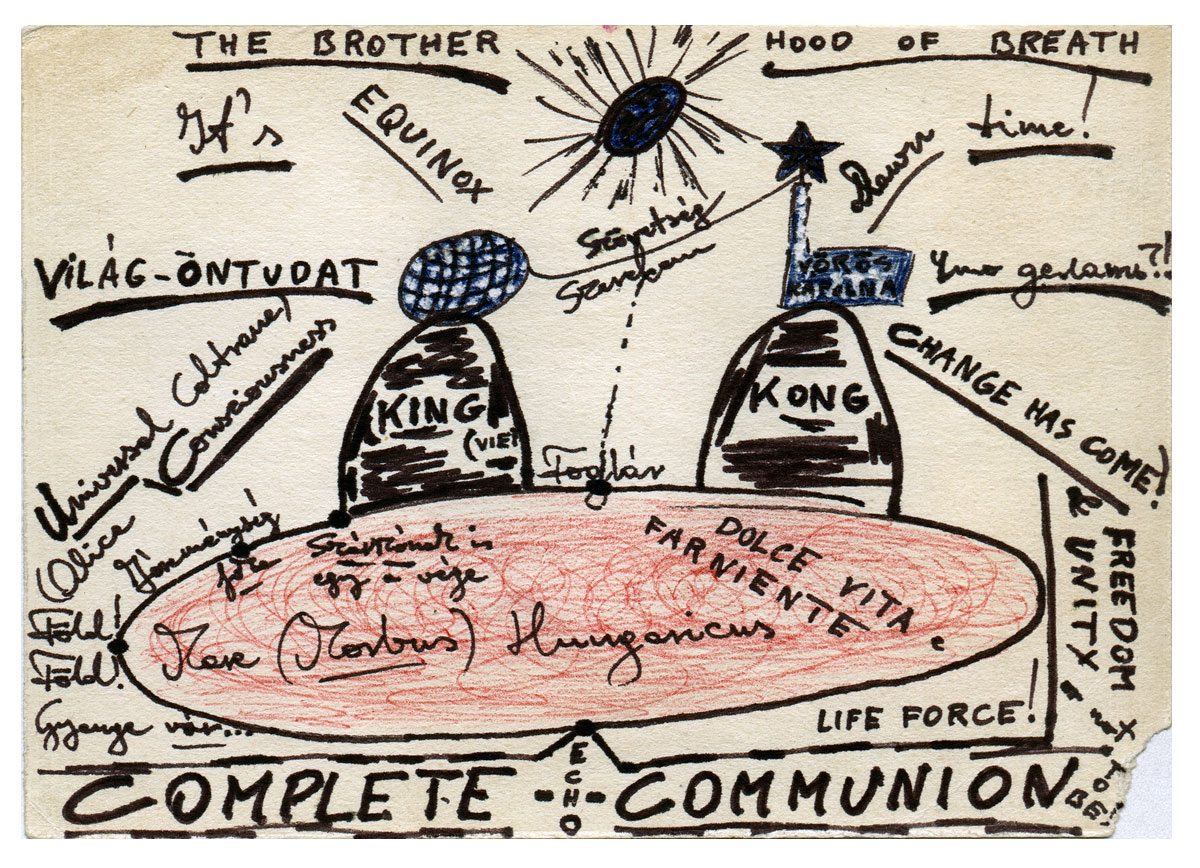
“We were working really hard on this project. Making King Kong – the puppet itself – was in itself extremely challenging. We were applying hair onto a sack and discussed the details of the performance while doing it. It was something like a scene from a Sekler spinning workshop or something like that, where everybody was telling their stories and in the meantime we were attaching more and more hair onto the ape-to-be […] There were many King Kong versions. György Kurtág Jr played his guitar in the tower, summoning the village dwellers to gather together, and the performance was kicked off with an actual kickoff on the path of the cemetery, along which the performers were walking. A person, said to be a dwarf, played by Can Togay, was locked in a cage and was holding on to a piece of King Kong’s skin. I don’t know where this idea came from. I think the question of authorship is quite interesting here too, because in some cases people invented roles for themselves, or they accepted a role recommended to them by others and they regarded their acceptance of these ideas as authorship. In any case, the production of this play was a team effort, and didn’t have one particular playwright, although we selected the texts and some of the situations in advance. So the bells were pealing in the tower, men in suits and ties and ladies in beautiful dresses were proceeding along the path, which was made even more special by the fact that these were hippy times and most young people wore rags and gaudy creations. We appeared in dark blue suits, i.e. in our Sunday best. We entered the chapel. I don’t remember if the supper scene, i.e. having a cocoa party, was on the first day or not. We invited the members of the audience for a Sunday cocoa and kalach (sweet bread) party, and during this time Péter Breznyik, who was sitting at the head of the table, was transformed into a woman. Cocoa, kalach, the audience, friends and friends of friends were there, I don’t know how many exactly. There are lots of photos of this event, so you could count if you wanted, how many of us were there and how many others were watching it from outside the door. So the ritual transformation into a woman began. Mariann Bálint and Anna Koós helped Péter Breznyik get transformed into a woman. Actually, it is from the photos that I remember the moment, a rather intense and scary one, when Péter [Breznyik] cut his wrist. What happened was he made a mistake because he did it lengthwise and not across so when he bent his arm the cut must have opened up too much. If he had made a cut across, the blood would have only oozed out, so it would have been only a few drops. But because of the way he did it, when he bent his arm, blood was gushing out and splattered onto the cocoa, the kalach and the white table. The audience was rather steeled: besides a few suppressed gestured, there was no panic, which also says volumes about our state of mind at the time, showing how we had to suppress our feelings and passions in that ghetto existence, which felt like we were pushed under water. It was so typical of what was happening in Hungary in those times. No one was affected by the sight of blood, at least not visibly, or they would have suffocated rather than let anyone see their reaction; not a single scream was heard. It was a truly shocking experience and if I saw it happen today, I’d surely pass out, or something horrible would happen. But back then, this whole thing was seen as normal since it was in the air generally as a form of art. The scene itself was a howl-like event, illustrating that everything can and should be done. This wonderful American woman, alias Péter Breznyik, appeared on the second day of the performance and some sort of a dialog started between her and the ape. And yes, I was the ape’s phallus. These were physical things. I came out on a slide, half-naked, with a swimming cap on my head – a rather symbolic representation. I recited a few lines from William Blake’s Proverbs of Hell… The King Kong idea was conceived in connection with the puppet shows I did for children on Sundays; sometimes I did a story from Hamlet or other things and once, by coincidence, King Kong came up… I don’t think it was a power symbol. William Blake’s texts of course contain ideas about how power operates, but these were texts of post-morality even back then, which meant the rejection of the prevailing morality used by those in power. Power doesn’t only mean those who politically govern a country, power is not only owned by those who execute political decisions; instead, it is an inner morality in which we live, i.e. in the street, among people, and based on which a person is called good or bad. We addressed the morality of friends in our play too: the way we see each other. And this Kindergarten situation was healthy and cynical in comparison to the power of politics.”
(Interview with Péter Halász, Vacation, Hungarian Television, 1998)
“I can’t remember who Galántai invited to join, or how and when, but the first really serious thing we did was the King Kong performance. What preceded it was that I went to Paris as a tourist and saw the King Kong film there, which had a profound effect on me. I excitedly told my friends about it and the first reaction to this was a children’s play, which Péter Halász did with puppets. Later, in Balatonboglár, we put on a three-day play with the title King Kong. Let me tell you a little story. When it comes to Balatonboglár, one didn’t just zip down there and do some art or give a lecture but we actually stayed there, for days or even weeks. We slept in the chapel, mostly on the floor because it was extremely hot. It was early dawn when a group of tourists appeared out of nowhere. They were foreigners: a father, a mother and a child. They couldn’t see me because I was lying behind the chapel door. The three-metre-tall furry black King Kong was standing in the chapel, in the place of the altar, where we built it. The father took a few steps towards the altar and made the sign of the cross. I felt that that was it: that nothing could have been more artistic and we couldn’t have asked for more than what happened then and there. I have no idea why he crossed himself. Either he couldn’t believe his eyes, or he did but he thought it was some form of religion. Basically I have no clue. But what matters is that the man crossed himself and left the chapel, having been touched by it all. This made me feel amazing […] Despite the fact that we later changed the setting of the play to a house – since we performed it at 20 Dohány Street too – but the natural environment was also made part of it. If I remember well, it began with György Kurtág playing some music, inspired by Jimmy Hendrix, in the church tower. I recall that he was playing the guitar and we, most of the performers, wearing costumes, were proceeding towards the chapel, very slowly, along a forest path, at times overtaking one another. So that’s how it started. A dwarf also took part in the performance – he was Can Togay, who was much younger than us; actually, the youngest member of the troupe – he played King Kong’s enemy. King Kong represented the power of instinct and emotion, and Péter Halász, impersonating King Kong’s phallus, was sliding in and out between its legs, while reciting Blake. Let’s just say that King Kong represented philistine pettiness. The dwarf was dragging himself on his knees with a bag pack and when he had no role, he stayed in a playpen kind of thing constructed using some bars, I don’t really know what kind of bars. It looked a bit like cages in a Zoo and people who came to see our performance or were simply walking around in the area would stare at him, the dwarf, and it was like a peep show in a zoo. On the day of the event, i.e. in the evening when we performed the play, most of the people came from Budapest by train or by car. We asked those who drove down to take their cars around the cage, put on their headlights and start tooting their cars’ horns at the dwarf. I think that actually made the improvised cage collapse and the dwarf made his way towards the chapel to take up a fight with King Kong. I don’t remember every detail but the way the cars were tooting in the dark with their headlights on, the way they kicked off the show, confirmed it to me that King Kong’s dramaturgy was perfectly fitting for the situation.”
(Interview with István Bálint, Vacation, Hungarian Television, 1998)
12–18 August 1973 - Kassák Theatre
accessories of the performances for children in the morning
12–13 August 1973 - (from Sunday evening to Monday morning) László Algol: The Chemistry Engineer and the Construction Foreman. The Personality of the Trinity (An Approximation Exercise).
12 and 15 August - Play with Birds
19–25 August 1973 - “Szövegek/Texts”, the first international exhibition of visual experimental poetry (organised by Dóra Maurer and Gábor Tóth)
